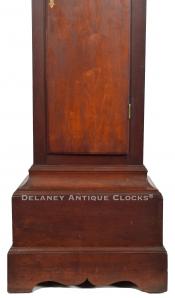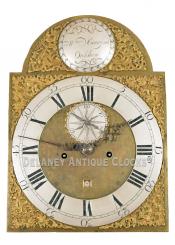William Crawford of Oakham, Massachusetts. This is a diminutive sized tall case clock. RR-59.
This very good example stands a mere 7 feet 4 inches tall to the top of the center finial and exhibits good narrow proportions. The case is constructed in cherry, and New England white pine is used as a secondary wood. The cherry wood currently retains an older and possibly original finish. The case stands on a simple cut-out bracket base. This large molding incorporating the feet is applied to the three sides of the base panel. The base section is compressed. This stylistic feature follows the early form. The waist section is long and narrow. It is fitted with a large tombstone-shaped waist door trimmed with a molded edge. In the arch of this door is a carved fan or ray that includes six petals. These are three-dimensional formed. The hood or bonnet features a swan's neck pediment design. The arches exhibit good height and are unusually narrow. Three large brass ball and spike finials are mounted to the top of the hood. The bonnet door is in an arched form and is fitted with glass. Four smoothly turned columns support the arch molding. These are mounted in brass capitals. The side of the hood is fitted with tombstone-shaped side lights. They are fitted with glass and provide visual access to the case's interior.
This style of this dial predates the painted dial. It is composed of a brass base sheet decorated with applied spandrels and a chapter ring. In the arch of the dial is the Maker's name-boss. It is signed in script engraving, "William Crawford / Oakham." The large chapter or time ring is also applied to the dial. This ring displays the hours in Roman numerals, and the five-minute markers are indicated in an Arabic style. The center of this section is nicely matted. This was most likely done to aid in one's ability to locate the hands while reading this dial. A brass dial will tarnish, making it difficult to read in a room lit by candles. The steel hour and minute hands are skillfully made. This dial also features the subsidiary seconds dial, which is engraved and countersunk into the surface of the dial. It is decorated with a compass star, and the edges of the opening are scalloped. The calendar date is displayed in the traditional location and can be viewed through the access square.
Behind the dial is a brass weight-driven movement designed to run for eight days on a full wind. It will also strike each hour on a cast iron bell. The plates are supported with five turned posts. All of which are mounted to a seat or a saddle board. The winding drums are grooved to accept the weight cord. The pendulum features a wooden rod and a brass-faced lead bob.
This fine Central Massachusetts tall clock was made circa 1785.
Inventory number RR-59.
William Crawford was born in Rutland, Massachusetts, on October 23, 1745. It is reported that he moved to Oakham in 1750 at the age of five. His father, Alexander, was one of the founders of this town. William and his brother John were both soldiers of the Revolution and eventually made the rank of Captain. In a letter written in 1934 by the Town Clerk of Oakham, the clockmaker "marched as Sergeant of the Oakham Company, when it responded to the alarm of July 23, 1773, from Rhode Island, and also Sergeant on the alarm of August 20, 1777, from Bennington. He also has credit for a campaign to Boston, beginning April 1, 1778." William married Mary Henderson in 1773 and fathered 11 children. He lived the rest of his life in Oakham and died there on June 30, 1833. He was 87 years old. His house is still standing today. Reportedly, the "Clock room" is still intact.
Oakham is still a very small town located in central Massachusetts. It is just North of the town of Spencer and to the West of the town of Rutland. Oakham was Incorporated in 1762. Originally it was called "Rutland West Wing." Some of its first settlers are reported as coming from Oakham, England, and hence took the name. Very little information is listed regarding this Maker. Several other tall clocks have been found. We have owned at least two other examples and have seen two examples sold at public auction. In addition, there are at least two on public display. One is in the collection at Old Sturbridge Village in Sturbridge, Massachusetts. Another composite brass dial example can be found in the Massachusetts Room at the Daughters of the American Revolution Museum located in our nation's Capital, Washington, DC. Many of Crawford's existing clocks are designed on a somewhat diminutive scale.












